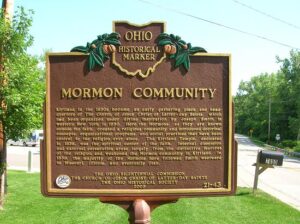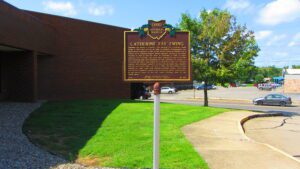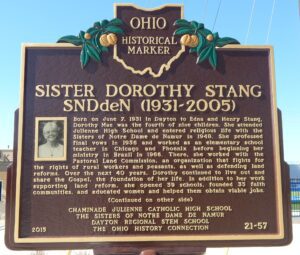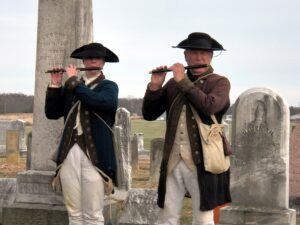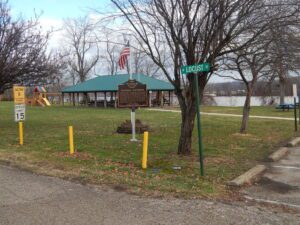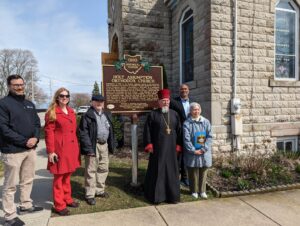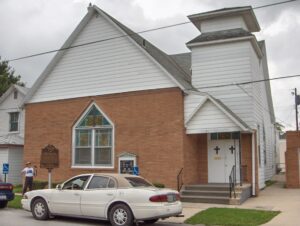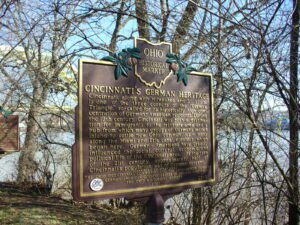, OH
Kirtland in the 1830s became an early gathering place and headquarters of The Church of Jesus Christ of Latter-day Saints, which had been organized under divine inspiration by Joseph Smith in western New York in 1830. Here the Mormons, as they are known outside the faith, created a religious community and introduced doctrinal concepts, organizational programs, and social practices that have been central to the religion ever since. The Kirtland Temple, dedicated in 1836, was the spiritual center of the faith. Internal dissension and external persecution arose largely from the distinctive features of the religion and weakened the Mormon community in Kirtland. In 1838, the majority of the Mormons here followed Smith westward to Missouri, Illinois, and eventually Utah.
, OH
Frances Dana (Barker) Gage was born on October 12, 1808, in Marietta. She married James L. Gage in 1829 and they raised eight children, including four sons who served with Union forces during the Civil War. Throughout much of her life, Frances was deeply involved with the Temperance and Anti-Slavery movements and Women’s Rights issues. Presiding over the Women’s Rights Convention in Akron in 1851, she invited Sojourner Truth to give her famous “Ain’t I a Woman” speech. The Gage family moved in 1853 to St. Louis, the western extension of the Mason-Dixon Line, where her life was threatened whenever she spoke out against slavery. During the Civil War, she traveled south to aid Union soldiers and teach freed slaves. Though crippled and permanently disabled by a stroke, she continued to lecture on social issues until 1867. Frances Dana Gage died on November 10, 1884, in Greenwich, Connecticut.
, OH
Born on June 7, 1931 in Dayton to Edna and Henry Stang, Dorothy Mae was the fourth of nine children. She attended Julienne High School and entered religious life with the Sisters of Notre Dame de Namur in 1948. She professed final vows in 1956 and worked as an elementary school teacher in Chicago and Phoenix before beginning her ministry in Brazil in 1966. There, she worked with the Pastoral Land Commission, an organization that fights for the rights of rural workers and peasants, as well as defending land reforms. Over the next 40 years, Dorothy continued to live out and share the Gospel, the foundation of her life. In addition to her work supporting land reform, she opened 39 schools, founded 35 faith communities and educated women and helped them obtain viable jobs. (Continued on other side)
, OH
Field Musician Richard W. Thompson. Tunes played on fife and drum regulated a soldier’s life in camp and his actions on the battlefield. Heard over the roar of battle and through the haze of smoke, fifes and drums – field music – communicated orders to massed troops quickly. Richard Willoughby Thompson (c. 1742-1837), buried in Fancher Cemetery, was a field musician during the American Revolution and the War of 1812. According to his grandson Henry’s recollections from the 1920s, Thompson was born in Dublin, Ireland, and enlisted in the British army, where his service culminated in his capture while picking blackberries. He switched allegiances, joined the colonials, and was sent to Virginia. Thompson was appointed the Fife Major of the 5th Virginia Regiment and remained a Fife Major as Virginia units organized during the war. (Continued on other side)
, OH
In 1955, at the age of 67, Emma Rowena “Grandma” Gatewood became the first woman to hike the 2,050 mile Appalachian Trail alone and in one season. The Gallia County, Ohio resident hiked the Appalachian Trail again in 1957 and 1964, becoming the first to walk its length three times. In 1959, she hiked the Oregan Trail, from Independence, Missouri to Portland, Oregon. She was a founder of the Buckeye Trail and life member of the Buckeye Trail Association, which named part of the trail after her. Grandma Gatewood was born in 1887 on a farm near Mercerville, one of 15 children, and died in 1973 at the age of 85, the mother of 11 and “grandma” to many more. SHe was inducted into the Appalachian Trail Hall of Fame in 2012.
, OH
Established in 1898 as the Russian Orthodox Church of the Dormition, Holy Assumption was founded by Carpatho-Russian immigrants from the Austro-Hungarian Empire. Constructed in 1905-1906, it is considered to be the oldest Orthodox church building in Ohio. Archbishop Tikhon, head of the Russian Orthodox Church in North America, consecrated the church and celebrated the first Liturgy. Tsar Nicholas II of Russian personally donated the four icons on the iconostas, or icon screen, as well as liturgical items. Both the Tsar and, by then Patriarch, Tikhon were murdered by the Bolsheviks during the 1917 Russian Revolution and were glorified as Saints of the Orthodox Church. Holy Assumption Orthodox Church continues to be a beacon of the Orthodox Faith on the Marblehead peninsula.
, OH
In spite of small numbers and being welcomed by the mostly white congregation of First Methodist Episcopal Church, African Americans in Findlay in the 1880s wanted to express their faith in ways that best reflected their freedoms and traditions. By the mid-1880s, the congregation was meeting in members’ homes and the Odd Fellows Hall, but began fund raising to build their own church in 1885. The congregation was admitted to the North Ohio Conference of the Third Episcopal District of the African Methodist Church in 1885, one of the first churches to be so admitted. The building on Liberty Street was well underway by the end of 1887 on a lot donated by Judge D. J. Cory. The original twenty foot by forty foot building cost $2,000 and immediately became a focal point for religion and social events for Findlay’s African American community. (Continued on other side)
, OH
Cincinnati, along with Milwaukee and St. Louis, is one of the three corners of the “German Triangle,” so-called for its historically high concentration of German-American residents. During the 19th century, Cincinnati was both a destination for immigrants to the tri-state area and a hub from which many groups of Germans moved inland to settle new Ohio communities-many along the Miami and Erie canal corridor which began here. German-Americans have greatly influenced the social, cultural, economic and political life of the Cincinnati area. At the turn of the 21st century, approximately half of Cincinnati’s population was of German descent. (Continued on other side)


